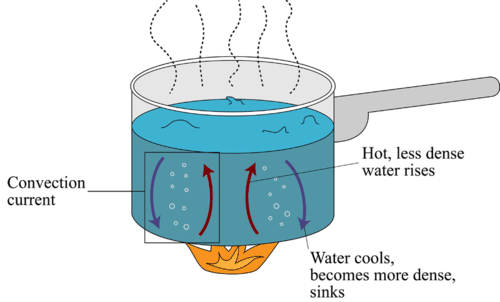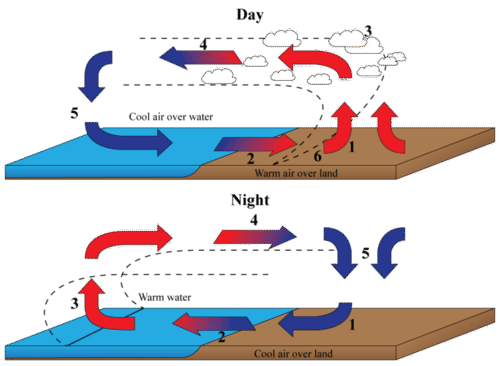15.6 对流
章节大纲
-
Do you see the water bubbling in this pot? The water is hot. How does all of the water in the pot get hot when it is heated only from the bottom by the flame? The answer is convection.
::你看见这锅里的水流了吗?水是热的,水是热的。当锅里的所有水都是热的,当它被火焰从底部加热的时候,它是如何被热的呢?答案就是对流。Defining Convection
::对等定义Convection is the transfer of by particles moving through a fluid (either a gas or a liquid). Thermal energy is the total of moving particles of matter, and the transfer of thermal energy is called . Convection is one of three ways that thermal energy can be transferred (the other ways are and thermal radiation). Thermal energy is always transferred from matter with a higher to matter with a lower temperature.
::通过流体(一种气体或一种液体)移动的粒子转移,即通过流体(一种气体或一种液体)移动的粒子转移的粒子。热能是迁移物质粒子的总和,热能的转移被称为 。对流是热能可以转移的三种方式之一(其他方式是热辐射 ) 。 热能总是从高物质转移到低温物质。How Does Convection Occur?
::如何对流观测的准确性?The Figure shows how convection occurs, using hot water in a pot as an example. When particles in one area of a fluid (in this case, the water at the bottom of the pot) gain thermal energy, they move more quickly, have more collisions, and spread farther apart. This decreases the density of the particles, so they rise up through the fluid. As they rise, they transfer their thermal energy to other particles of the fluid and cool off in the process. With less , the particles move more slowly, have fewer collisions, and move closer together. This increases their density, so they sink back down through the fluid. When they reach the bottom of the fluid, the cycle repeats. The result is a loop of moving particles called a convection current .
::图中显示了如何发生对流,用锅中的热水作为例子。当液体的一个区域(这里指的是锅底的水)的粒子获得热能时,它们移动得更快,碰撞更多,扩散得更远。这降低了粒子的密度,因此它们从液体中上升。当它们上升时,它们将热能转移到液体中的其他粒子,并在过程中冷却下来。粒子移动得更慢,碰撞更少,并一起移动得更近。这增加了它们的密度,因此它们会从液体中沉回。当它们到达液体底部时,循环会重复。结果就是移动粒子的循环,称为对流。Examples of Convection
::对等实例Convection currents transfer thermal energy through many fluids, not just hot water in a pot. For example, convection currents transfer thermal energy through molten rock below Earth’s surface, through water in the oceans, and through air in the atmosphere. Convection currents in the atmosphere create winds. You can see one way this happens in the Figure . The land heats up and cools off faster than the water because it has lower . Therefore, the land gets warmer during the day and cooler at night than the water does. During the day, warm air rises above the land and cool air from the water moves in to take its place. During the night, the opposite happens. Warm air rises above the water and cool air from the land moves out to take its place.
::对流流流通过许多流体转移热能,而不仅仅是锅中的热水。例如,对流流流通过地表以下熔岩、海洋中的水和大气中的空气转移热能。对流流流在大气中产生风。从图中可以看到这种情况发生的方式之一。陆地温度上升,冷却速度比水低的水快。因此,陆地白天变暖,晚上比水凉快。白天,温暖的空气在陆地上上升,而从水流移动到其他地方的空气又冷却。在夜间,情况正好相反。温暖的空气在水面上上升,而陆地的冷空气则取代了地面。Q: During the day, in which direction is thermal energy of the air transferred? In which direction is it transferred during the night?
::问题:白天,空气的热能向哪个方向转移?夜间的热能向哪个方向转移?A: During the day, thermal energy is transferred from the air over the land to the air over the water. During the night, thermal energy is transferred in the opposite direction.
::A:白天,热能从地面的空气转移到水的空气,夜间,热能转移到相反的方向。Summary
::摘要-
Convection is the transfer of thermal energy by particles moving through a fluid. Thermal energy is always transferred from an area with a higher temperature to an area with a lower temperature.
::对流是指通过流体流动的微粒转移热能,热能总是从温度较高的地区转移到温度较低的地区。 -
Moving particles transfer thermal energy through a fluid by forming convection currents.
::通过形成对流流,通过流体移动粒子,通过流体转移热能。 -
Convection currents move thermal energy through many fluids, including molten rock inside Earth, water in the oceans, and air in the atmosphere.
::对流流通过许多流体移动热能,包括地球上熔岩、海洋中的水和大气中的空气。
Review
::回顾-
What is convection?
::什么是对流? -
Describe how convection occurs and why convection currents form.
::描述对流是如何发生的,为什么对流流流形成。 -
Add arrows representing convection currents to the room in the
Figure
to show how thermal energy moves from the radiator to the rest of the room. Label areas of the room that are warm and cool.
::在图中,将代表对流电流的箭头添加到房间,以显示热能如何从散热器转移到房间的其余部分。房间的标签区域是温暖和凉爽的。
-
Convection is the transfer of thermal energy by particles moving through a fluid. Thermal energy is always transferred from an area with a higher temperature to an area with a lower temperature.



